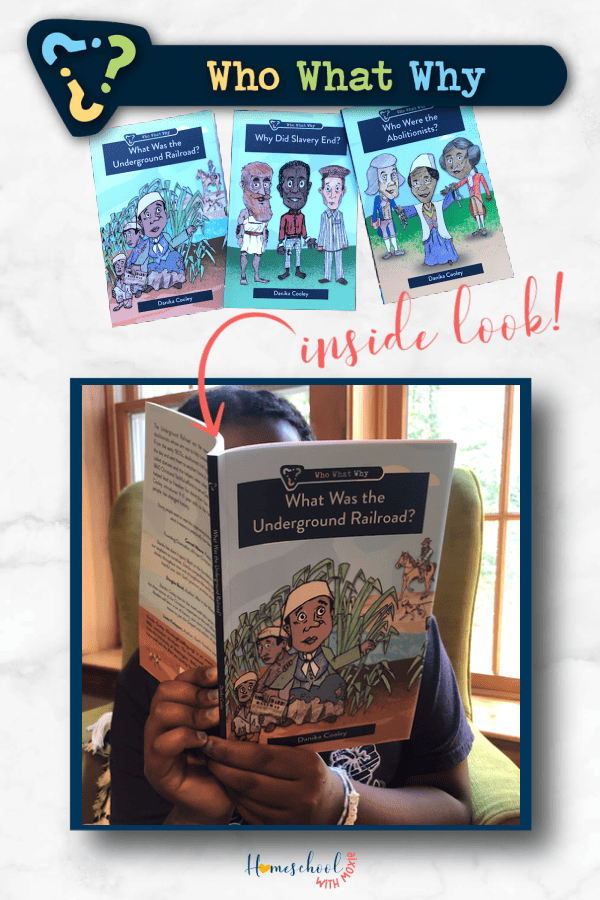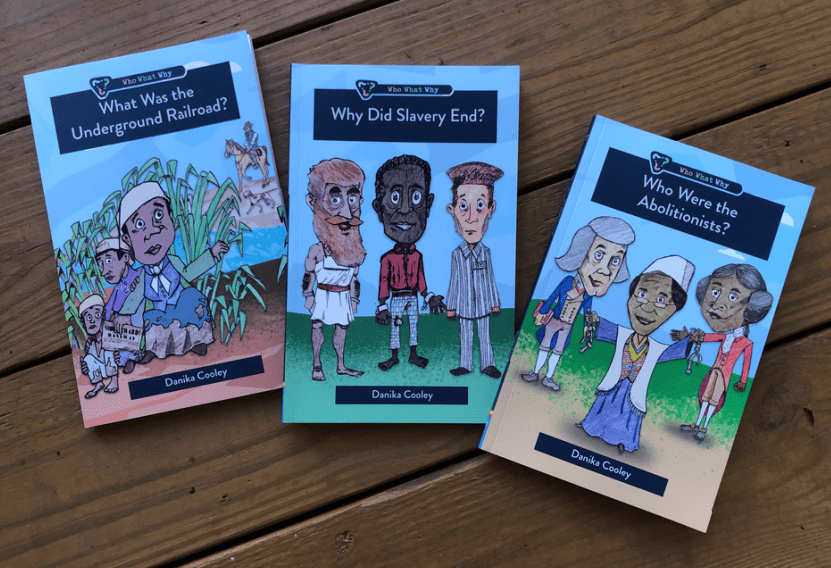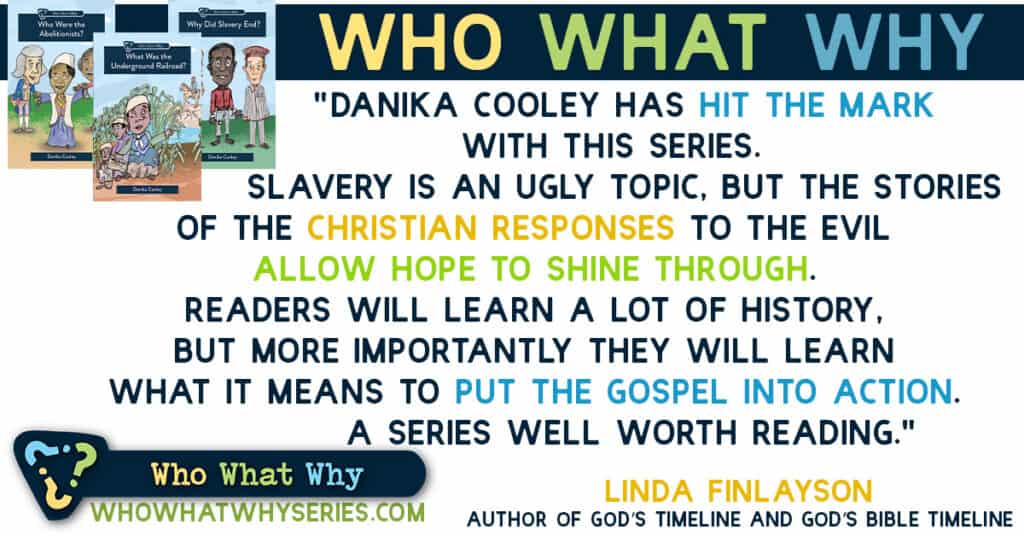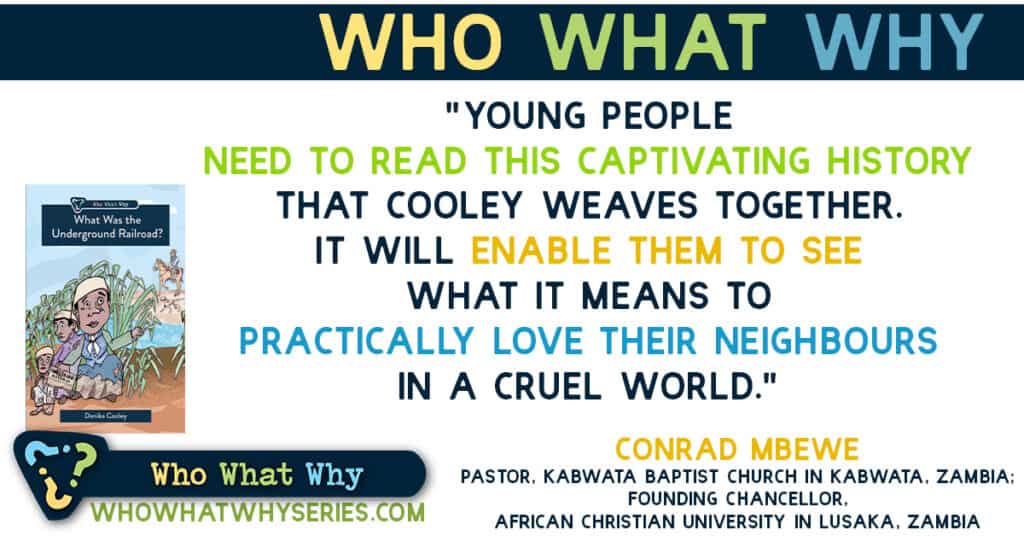Are you looking for a great set of living books that will draw your kids in? Want a way to explain some challenging concepts to your kids – like abolition, slavery, and the Underground Railroad? The Who What Why Series is expanding and you’ll love the newest three books, especially if you’re studying American history this year.

My posts contain affiliate links. I received free books in exchange for my honest review.
Why Does Christian History Matter?
It can be challenging to find the right resources to teach our kids about sensitive topics like slavery. What were Christians doing during the modern era to combat this evil? Was God still in control even when slavery was legal? How should loving God and others spur Christians to action against evil in the culture?
These are some of the issues that Danika Cooley confronts in the most recent books in the Who What Why Series focusing on the 18th-19th century struggle to rid the United States of slavery.
Danika does a great job at tracing the role that specific Christians play in confronting evil in their society. She emphasizes God’s sovereignty in placing us in a specific time in history in order to glorify God and serve others with our actions. That’s a hopeful message for our kids in this current cultural climate. God can use them to make a difference in the world as a Christian.

Who Wrote The Who What Why Series?
Danika Cooley from Thinking Kids Press is the author of Who What Why Series. This latest installment of books covering the modern era follows her original three books about the Reformation for kids.
Each book is just under 100 pages and includes black and white illustrations. There’s also a helpful timeline at the end of each book, compiling all the relevant historical events that were covered.
While these books can be used on their own, Danika has FREE lapbooks to go along with each one and extend the learning.

Here’s an overview of each book and how the author approaches the question.
Who Were the Abolitionists?
Danika does not approach the story of ten abolitionists from a purely historical perspective – that is, merely focusing on dates, events, and actions. But she gets to the heart of the matter and the fact that many of these Christian abolitionists were motivated by truth they knew from the Word of God above all. That truth says that all people are created in the image of God and are worthy of life, liberty, and respect because they bear that image.
In addition to focusing on the Christian motivation behind the abolitionist movement, Danika talks about how each of these heroes uses his or her unique gifts and place in history to address the injustice of slavery. Drawing on the biblical story of Esther and how God placed her in a unique position of influence “for such a time as this,” Danika also shows how the abolitionists – and the reader – has been placed uniquely in history by God’s providence.

The author calls out the sin and evil of slavery in these books for kids about slavery and abolition. She highlights that one sin leads to another and many enslaved families were broken apart because of the sin of slavery.
Sin leads to more sin. Slavery stole God’s Word from people who were enslaved. It stole God’s good gift of family and marriage from millions. Slavery also rotted the souls of the enslavers. They became murderers and thieves, taking what was not theirs, and killing enslaved humans with no consequences here on this earth.
Danika Cooley, Who Were the Abolitionists? (page 18)
But into the darkness of the culture, thousands of abolitionists decided to do their part in addressing and fighting against the sin of slavery.
Each chapter in this book focuses on a different abolitionist hero of the 18th or 19th century, including:
- Granville Sharp
- Phillis Wheatley
- Olaudah Equiano
- Thomas Clarkson
- William Wilberforce
- Zachary Macaulay
- William Knibb
- Sojourner Truth
- Frederick Douglass
- Harriet Tubman
Danika ends this book with a challenge to the reader to consider how God will use their gifts to impact history. She constantly highlights God’s control over history and providential leading of individual Christians to make a difference in their culture.
What Was the Underground Railroad?
Danika begins this particular book with a helpful explanation for 9-11 year olds about why this system of helping slaves flee to safety was called the Underground Railroad. And you’ll be interested to know that Danika doesn’t shy away from the hard questions.
Weren’t there Christians on both sides of the slavery issue? Are Christians allowed to disobey laws in order to do right? We’re still grappling with this last question even today.

The author challenges the reader to always go to the Bible for answers. She then reminds kids of the story of Obadiah during the reign of wicked king Ahab. Obadiah disobeyed the king’s command and hid prophets so they wouldn’t be killed. Again, in book of Acts, Peter and the apostles boldly proclaimed that they must obey God when the laws of the land go against God’s laws.
With this background of resisting sinful laws, Danika pulls the reader into the 1850’s with the Fugitive Slave Law. From there, her chapters weave in and out with personal narratives of freed slaves and conductors on the Underground Railroad. From the more obscure names like Arnold Gragston to well-known personalities like Harriet Tubman, each story showcases bravery and courage.
But then Danika pulls all the threads together in the narrative of the Underground Railroad to highlight how God used ordinary people to change history.
People who obey God, not man, change the course of history. They don’t change it all at once. No, history is changed just a little at a time, one heart at a time. The most important thing people who love Jesus can do is tell others about the love of Jesus.”
Danika Cooley, What Was the Underground Railroad? (page 79)
Why Did Slavery End?
It can be challenging to find books for kids about slavery that come from a Christian worldview. This worldview is essential because it emphasizes the inherent worth in all humans because they are made in God’s image.
This book is intended for 9-11 year-olds to be able to grasp the two hundred year fight to end the global slave trade and legal practice of slavery. Danika brings to light the role that countless Christians played to love their neighbors as themselves as well as the bravery of enslaved people who fought to be free.
Danika sets the stage with a gentle and age-appropriate approach to the topic of slavery. All the explanations are based on a biblically-infused worldview lens.
We are going to look at an ugly sin that was ignored not just for days, but centuries. However, God’s people loved their neighbors – and their neighborly love changed history.
Danika Cooley, Why Did Slavery End? (page 7)
Here’s how she describes the practice of slavery.
Even though God created us to love each other, some wicked people kidnapped other people and forced them to work. We call that slavery. Slavery hurts human beings.
Danika Cooley, Why Did Slavery End? (page 7)
The author reminds readers that slavery has existed for all of human history – from Joseph in Egypt to African tribes, to the enslaved British and Irish. Even the Greeks and Romans enslaved others.

Danika anticipates the questions that she knows people will ask about this topic rather than ignoring those challenges. One such common issue is that “God himself ordered the enslavement of some people groups in the Old Testament.” She explains that this was a specific punishment from God on these people for their grevious sins against God.
She also distinguishes the nature of chattel slavery in America from bondservants in biblical times, who may have entered servitude in order to pay off debt. Danika discusses the racial component to American slavery and that it goes against God’s Word which tells us that all humans are made in the image of God.
The author traces the history of the abolition movement throughout Europe and into the Americas. Following that history, Danika dives into a theological explanation of the imago Dei at an understandable level for kids ages 9-11. Yes! Kids are not too young to study theology and doctrine. So while this is a retelling of historical events, the theological and worldview basis for abolition is woven throughout the book.
Danika addresses the hidden sins of the heart of Christians during the Civil War who defended slavery in this book for kids about slavery:
In fact, knowing God’s Word keeps us from making up strange or even wicked definitions for important words like justice and kindness – like the plantation owners and government officials did during the time of slavery…
The wonderful thing is that when you love and seek Jesus, the Holy Spirit will grow the fruit of the Spirit in your life.
Danika Cooley, Why Did Slavery End? (pages 68-69)
But this book does not end with the American Civil War and emancipation. The author goes on to talk about slavery in every part of the world and even into the 20th century. She ends with the hopeful truth that Jesus the Messiah has come to set us free from slavery to sin.
Listen to the Podcast
On episode 234 of the Homeschool with Moxie Podcast as we discuss The Who What Why Series and my personal connection to the Underground Railroad. These are important books for kids about slavery, abolition, the Underground Railroad, and how ordinary people made a difference in their culture.

Inside Peek Into The Who What Why Series
Here’s a look inside the newest books in the Who What Why Series so you can get a feel for the reading level and layout of each book. I know you’ll want to see how the author approaches these challenging topics for this age-level, so an inside peek into these books for kids about slavery is below.
Where can I find The Who What Why Series?
You can find the Who What Why Series and download FREE lapbooks for each book! These would make a great supplement or even the main spine of a history curriculum for your elementary kids. You could add in even more geography studies, biographies, or other interesting resources. Take some virtual field trips to key places in the abolition movement.
It is a challenge to find books for kids about slavery and other hard topics, but you’ll appreciate Danika’s approach from a biblical perspective.


Christian literature encompasses a wide range of books that explore various aspects of the Christian faith, including theology, spirituality, biblical studies, devotional literature, fiction, and more. Here are some categories of Christian books along with a few notable examples